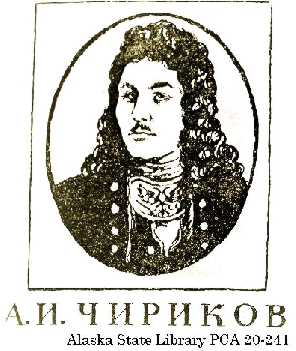Aleksei Chirikov facts for kids
Quick facts for kids
Aleksei Chirikov
|
|
|---|---|
 |
|
| Native name |
Алексей Ильич Чириков
|
| Born | December 24, 1703 Luzhnoye Village, Tula Oblast, Tsardom of Russia |
| Died | June 4, 1748 (aged 44) Moscow, Russian Empire |
| Allegiance | Russian |
| Rank | Captain |
| Other work | Navigator |
Aleksei Ilyich Chirikov (Russian: Алексе́й Ильи́ч Чи́риков; December 24, 1703 – June 4, 1748) was a brave Russian navigator and captain. He was one of the first Russians to reach the northwest coast of North America. He explored and mapped parts of the Aleutian Islands. He did this while working with Vitus Bering during a huge journey called the Great Northern Expedition.
Contents
Early Life and Training
Aleksei Chirikov was born on December 24, 1703. He grew up in Luzhnoye Village, which was part of the Tsardom of Russia.
In 1721, Aleksei Chirikov finished his studies at the Naval Academy. This training prepared him for a life at sea. He became a skilled navigator, someone who plans and directs the course of a ship.
Great Expeditions
Chirikov played a very important role in two major Russian expeditions. These were the First Kamchatka expedition and the Great Northern Expedition.
Working with Vitus Bering
From 1725 to 1730, and again from 1733 to 1743, Chirikov was the main helper, or "deputy," to Vitus Bering. Bering was a famous Danish explorer who led these big Russian journeys.
The Second Kamchatka Expedition
In May 1741, Chirikov set sail on his ship, the St Paul. Bering was on his ship, the St Peter. They both left a place called Petropavlovsk-Kamchatsky and headed east.
A Stormy Separation
After June 20, a big storm hit their ships. Chirikov and Bering got separated and never saw each other again.
Reaching North America
On July 15, 1741, Chirikov saw land! It was Baker Island off Prince of Wales Island. This area is now known as the Alaska Panhandle. It was about 450 miles southeast of where Bering landed.
Challenges at Sea
Chirikov tried to find a safe place to dock his ship, but he couldn't. He sailed north along Baranof Island. He sent out a small boat to look for an anchorage, but it didn't come back. He sent a second small boat, and it also disappeared.
Without any small boats, Chirikov couldn't explore the coast or get fresh water. After waiting as long as he could, he had to leave the area. On July 27, he sailed west.
Discovering Islands
As he sailed, Chirikov saw the Kenai Peninsula, Kodiak Island, and Adak Island. These islands are part of the Aleutian Islands. His ship was running very low on water. Finally, he reached Petropavlovsk on October 12, 1741.
Later Discoveries and Maps
In 1742, Chirikov led a search party to find Bering's ship, the St. Peter. During this trip, he found Attu Island.
Chirikov also helped create the final map of all the new lands Russia had discovered in the Pacific Ocean. This map was finished in 1746.
Final Years
In 1746, Chirikov became the Director of the Academy of the Naval Guard in St. Petersburg. He passed away on June 4, 1748, at the age of 44.
Legacy
Aleksei Chirikov's name lives on in many places.
- Capes on the Kyūshū Island and Attu Island are named after him.
- Parts of Anadyr Bay and Tauyskaya Bay also carry his name.
- There's an underwater mountain in the Pacific Ocean called Chirikov.
- Chirikof Island and Cape Chirikof on Baker Island are also named in his honor.
See Also
 In Spanish: Alekséi Chírikov para niños
In Spanish: Alekséi Chírikov para niños

